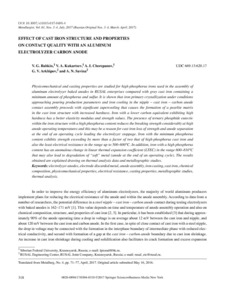Показать сокращенную информацию
Effect of Cast Iron Structure and Properties on Contact Quality with an Aluminum Electrolyzer Carbon Anode
| Автор | Бабкин, Владимир Григорьевич | |
| Автор | Кукарцев, Виктор Алексеевич | |
| Автор | Черепанов, Александр Иванович | |
| Автор | Архипов, Геннадий Владимирович | |
| Автор | Савина, Александр Николаевич | |
| Дата внесения | 2018-02-07T07:26:13Z | |
| Дата, когда ресурс стал доступен | 2018-02-07T07:26:13Z | |
| Дата публикации | 2017-08 | |
| Библиографическое описание | Бабкин, Владимир Григорьевич. Effect of Cast Iron Structure and Properties on Contact Quality with an Aluminum Electrolyzer Carbon Anode [Текст] / Владимир Григорьевич Бабкин, Виктор Алексеевич Кукарцев, Александр Иванович Черепанов, Геннадий Владимирович Архипов, Александр Николаевич Савина // Metallurgist. — 2017. — Т. 61 (3-4). — С. 318-324 | |
| ISSN | 00260894 | |
| URI (для ссылок/цитирований) | https://link.springer.com/article/10.1007%2Fs11015-017-0495-8 | |
| URI (для ссылок/цитирований) | https://elib.sfu-kras.ru/handle/2311/69615 | |
| Описание | Текст статьи не публикуется в открытом доступе в соответствии с политикой журнала. | |
| Аннотация | Physicomechanical and casting properties are studied for high-phosphorus irons used in the assembly of aluminum electrolyzer baked anodes in RUSAL enterprises compared with gray cast iron containing a minimum amount of phosphorus and sulfur. It is shown that iron primary crystallization under conditions approaching pouring production parameters and iron cooling in the nipple – cast iron – carbon anode contact assembly proceeds with significant supercooling that causes the formation of a pearlite matrix in the cast iron structure with increased hardness. Iron with a lower carbon equivalent exhibiting high hardness has a better elasticity modulus and strength values. The presence of ternary phosphide eutectic within the iron structure with a high phosphorus content reduces the breaking strength considerably at high anode operating temperatures and this may be a reason for cast iron loss of strength and anode separation at the end of an operating cycle leading the electrolyzer stoppage. Iron with the minimum phosphorus content exhibits strength exceeding by more than a factor of two that of high-phosphorus cast iron and also the least electrical resistance in the range up to 500–600°C. In addition, iron with a high phosphorus content has an anomalous change in linear thermal expansion coeffi cient (LTEC) in the range 600–810°C that may also lead to degradation of “soft” metal (anode at the end of an operating cycle). The results obtained are explained drawing on thermal analysis data and metallographic studies. | |
| Тема | electrolyzer anodes | |
| Тема | electrode discarded metal | |
| Тема | anode assembly | |
| Тема | iron | |
| Тема | casting | |
| Тема | cast iron | |
| Тема | chemical composition | |
| Тема | physicomechanical properties | |
| Тема | electrical | |
| Тема | resistance | |
| Тема | casting properties | |
| Тема | metallographic studies | |
| Тема | thermal analysis | |
| Название | Effect of Cast Iron Structure and Properties on Contact Quality with an Aluminum Electrolyzer Carbon Anode | |
| Тип | Journal Article | |
| Тип | Published Journal Article | |
| Страницы | 318-324 | |
| ГРНТИ | 53.37 | |
| Дата обновления | 2018-02-07T07:26:13Z | |
| DOI | 10.1007/s11015-017-0495-8 | |
| Институт | Политехнический институт | |
| Подразделение | Кафедра материаловедения и технологии обработки материалов | |
| Журнал | Metallurgist | |
| Квартиль журнала в Scopus | Q3 | |
| Квартиль журнала в Web of Science | Q4 |

